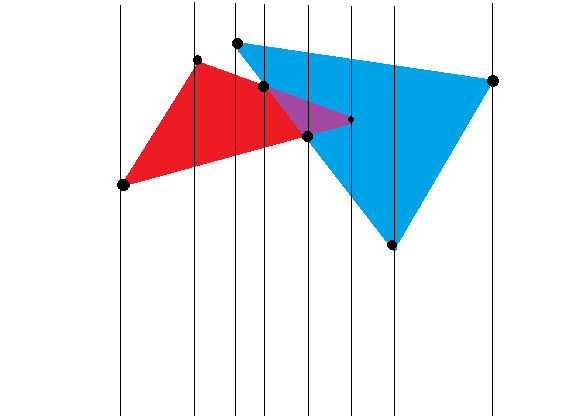【题目描述】 给出$n$个三角形,求它们并的面积。
【输入格式】 第一行为$n(n leq 100)$,即三角形的个数 以下$n$行,每行$6$个整数$x_1, y_1, x_2, y_2, x_3, y_3$,代表三角形的顶点坐标。坐标均为不超过$10^6$
【输出格式】 输出并的面积$u$, 保留两位小数。
题解

我们把三角形的所有顶点和所有交点全部抠出来 然后过每一个点作一条平行于y轴的直线
容易发现 任意相邻两条直线之间的有效面积都是一个(也可能是多个)三角形或矩形的面积
所以 只要我们求出左边那条直线穿过三角形的长度$ld$和右边那条直线的$rd$,那么总面积就加上$frac{(ld+rd)*(x_r-x_l)}{2}$就好啦!
怎么求?具体来说 就是对于每个三角形分别求出这条线$x=k$穿过它的范围$[a,b]$,然后区间求并即可
怎么求?对于每个三角形 算出这条线和它的三边有几个交点 如果是3个交点就说明这条线过它的一个顶点 如果2个就说明穿过了两条边 如果0个或1个就不用管这个三角形了
万一有一个三角形有一条边也平行于y轴 与某条直线产生了无数个交点呢?
注意到答案保留两位小数就可以了 我们可以用一些奇技♂淫巧
把那种与y轴平行的三角形边稍稍倾斜一个小角度即可 对面积的影响微乎其微
至于求交点那些建议用计算几何算 避免被卡精度
代码
#include <bits/stdc++.h>
using namespace std;
const double eps = 1e-8;
inline int sgn(double x) {
if (fabs(x) < eps) return 0;
return (x < 0) ? -1 : 1;
}
struct point{
double x, y;
point(double xx = 0.0, double yy = 0.0): x(xx), y(yy) {}
};
typedef point vec;
struct edge{
point a, b;
edge(point aa = point(), point bb = point()): a(aa), b(bb) {}
};
inline vec operator + (vec A, vec B) {
return vec(A.x + B.x, A.y + B.y);
}
inline vec operator - (point A, point B) {
return vec(A.x - B.x, A.y - B.y);
}
inline vec operator * (vec A, double p) {
return vec(A.x * p, A.y * p);
}
inline vec operator / (vec A, double p) {
return vec(A.x / p, A.y / p);
}
inline bool operator < (const point A, const point B) {
return A.x < B.x || (sgn(A.x - B.x) == 0 && A.y < B.y);
}
inline double dot(vec A, vec B) {
return A.x * B.x + A.y * B.y;
}
inline double cross(vec A, vec B) {
return A.x * B.y - A.y * B.x;
}
inline point line_intersection(point P, point P2, point Q, point Q2) { //求交点
vec v = P - P2, w = Q - Q2;
vec u = P - Q;
double t = cross(w, u) / cross(v, w);
return P + v * t;
}
inline bool GFXJ(point A, point B, point P, point Q) { //规范相交
double c1 = cross(B - A, P - A), c2 = cross(B - A, Q - A);
double c3 = cross(Q - P, A - P), c4 = cross(Q - P, B - P);
if (sgn(cross(B - A, P - A)) == 0) return 0;
return sgn(c1) * sgn(c2) < 0 && sgn(c3) * sgn(c4) < 0;
}
inline bool BGFXJ(point A, point B, point P, point Q) { //不规范相交
double c1 = cross(B - A, P - A), c2 = cross(B - A, Q - A);
double c3 = cross(Q - P, A - P), c4 = cross(Q - P, B - P);
if (sgn(cross(B - A, P - A)) == 0) return 0;
return sgn(c1) * sgn(c2) <= 0 && sgn(c3) * sgn(c4) <= 0;
}
int n, tot, ee;
double ans;
point p[100005];
edge e[305];
vector<pair<double, double> > sol;
double solve(double x) {
sol.clear();
point pp = point(x, -2e6); point q = point(x, 2e6);
for (int i = 1; i <= ee; i += 3) {
if (BGFXJ(pp, q, e[i].a, e[i].b) + BGFXJ(pp, q, e[i+1].a, e[i+1].b) + BGFXJ(pp, q, e[i+2].a, e[i+2].b) < 2) {
continue;
}
pair<double, double> tmp;
tmp.first = 2e6, tmp.second = -2e6;
for (int j = 0; j <= 2; j++) {
if (BGFXJ(pp, q, e[i+j].a, e[i+j].b)) {
double now = line_intersection(pp, q, e[i+j].a, e[i+j].b).y;
tmp.first = min(tmp.first, now);
tmp.second = max(tmp.second, now);
}
}
sol.push_back(tmp);
}
sort(sol.begin(), sol.end());
if (!sol.size()) return 0;
double lst = sol[0].first, ret = 0;
for (int i = 0; i < sol.size(); i++) {
if (sol[i].second <= lst) continue;
if (sol[i].first > lst) ret += sol[i].second - sol[i].first;
else ret += sol[i].second - lst;
lst = sol[i].second;
}
return ret;
}
int main() {
scanf("%d", &n);
for (int i = 1; i <= n; i++) {
scanf("%lf %lf %lf %lf %lf %lf", &p[tot+1].x, &p[tot+1].y, &p[tot+2].x, &p[tot+2].y, &p[tot+3].x, &p[tot+3].y);
if (p[tot+1].x == p[tot+2].x) p[tot+2].x += 0.001;
else if (p[tot+1].x == p[tot+3].x) p[tot+3].x += 0.001;
else if (p[tot+2].x == p[tot+3].x) p[tot+3].x += 0.001;
e[++ee] = edge(p[tot+1], p[tot+2]);
e[++ee] = edge(p[tot+2], p[tot+3]);
e[++ee] = edge(p[tot+3], p[tot+1]);
tot += 3;
}
for (int i = 1; i <= ee; i++) {
for (int j = i + 1; j <= ee; j++) {
if (GFXJ(e[i].a, e[i].b, e[j].a, e[j].b)) {
p[++tot] = line_intersection(e[i].a, e[i].b, e[j].a, e[j].b);
}
}
}
sort(p + 1, p + tot + 1);
double lst = 0, lstx = 114514, now = 0;
for (int i = 1; i <= tot; i++) {
now = solve(p[i].x);
if (sgn(lstx - 114514) != 0) {
ans += (p[i].x - lstx) * (now + lst) / 2;
}
lstx = p[i].x;
lst = now;
while (p[i+1].x == p[i].x) i++;
}
printf("%.2lf
", ans);
return 0;
}